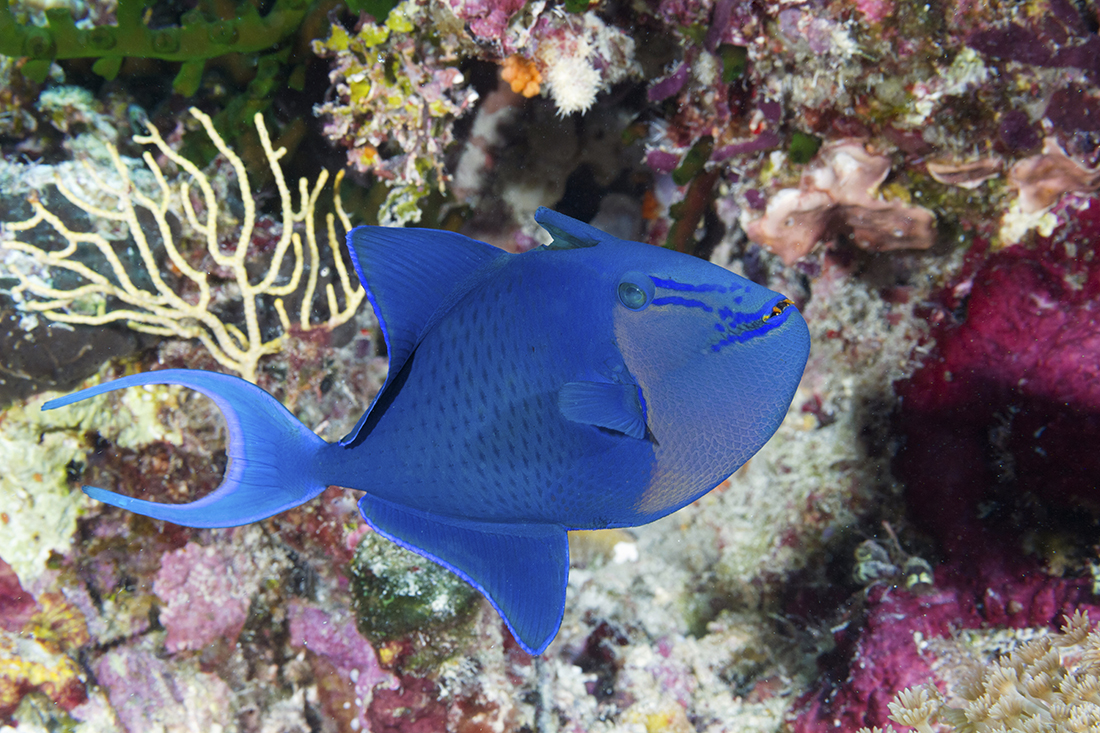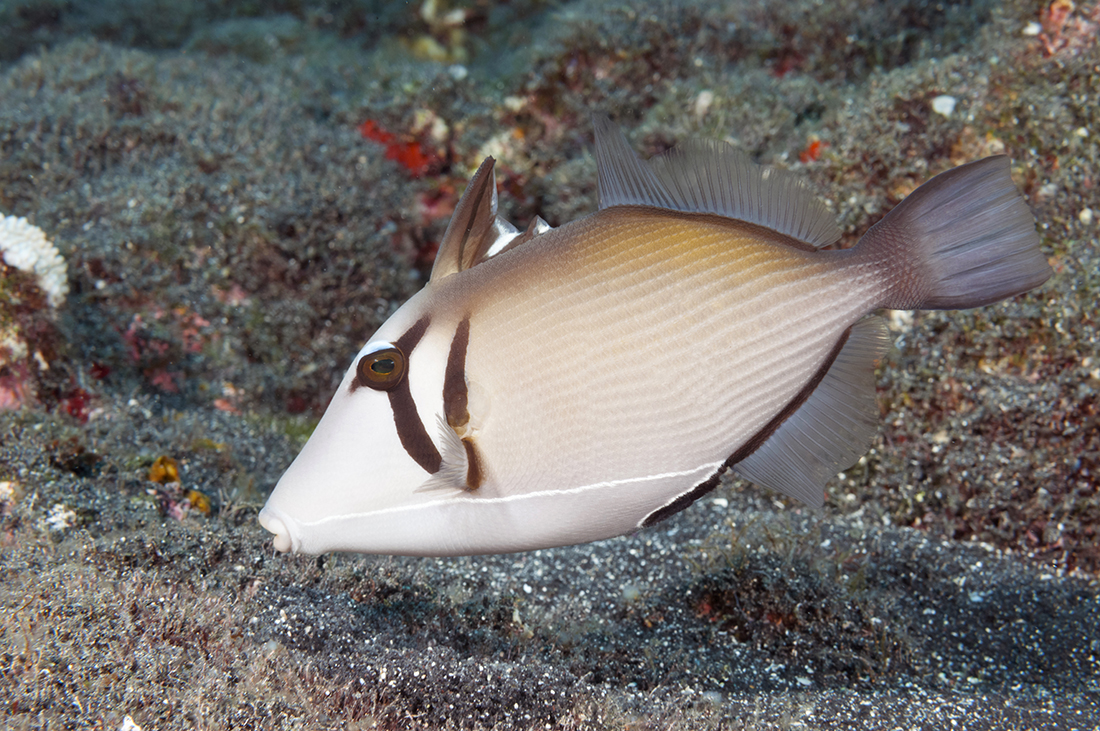Triggerfish Happy
Discover why the triggerfish on Wakatobi reefs are worth a closer look, but not too close.
One of the many things that bring divers and snorkelers to Wakatobi is the chance to encounter rare and exotic marine life. Making these special finds is always exciting, but just as often, the seemingly ordinary and abundant inhabitants of the reef can prove equally fascinating. Case in point is the various species of triggerfish, filefish, and durgons that are familiar sights in our waters. Come across one flutter-swimming it’s way through coral rubble and it might seem like there’s nothing much going on. Follow along for a while, however, and things might get interesting. Just don’t get too close, because these fish like their personal space.

Triggers, like this Redtooth triggerfish, grow tough skins with non-overlapping, diamond-shaped scales that are the biological equivalent of armor plating. Photo by Walt Stearns
Designed for defense
Some 40 species of triggerfish can be found in tropical and subtropical oceans throughout the world, ranging in size from a few centimeters to almost a meter. The most abundant and diverse are found between the Indian Ocean and Indo-Pacific, which make the reef environments around Wakatobi especially good for seeing them.
Often sporting intricate and colorful geometric patterns, or in some cases spots, triggers are most easily recognized by their rhomboid-shaped bodies, large heads, small mouths and distinctive fin patterns. It is the unusual spike-like dorsal fin that inspired these fishes’ common name—more on that in a moment. The caudal (aka “tail”) fin comes into play only for short bursts of speed. Most of the time, triggers propel themselves with undulations of their enlarged anal and posterior dorsal fins, a method scientists call balistiform locomotion. This technique, which resembles the fluttering motions of a bird in flight, doesn’t provide much speed, but it allows for precise slow-speed maneuvering.

The Scythe triggerfish has the ability to rapidly change its scythe-marking, located behind the eye, from a bright yellow- orange to dark brown, and also may darken or lighten the shades of its body color. Photo by Walt Stearns
Since triggers are unlikely to out-swim would-be predators, they defend themselves in other ways. They grow tough skins with non-overlapping, diamond-shaped scales that are the biological equivalent of armor plating. Gills are hidden behind a thick growth of protective skin, as are the pelvic fins, which are also fused to form a single spine. Taken together, these adaptations make triggerfish a hard meal to bite into, and they have another trick that makes them even harder to swallow.
When threatened, a triggerfish will run for cover, wedging into a crevice and raising the dorsal and anal spines to lock itself in place and thwart any attempts at extrication.
Up top, the trigger’s anterior dorsal fin is reduced to just three spines, which are normally retracted. When threatened, the trigger will raise these spines, locking the large, sharp leading spine in place with the shorter second spine. This technique creates a rigid spike that could certainly stop a predator from chomping down and swallowing. The locking the spines can also be deployed to form an anchor. When threatened, a triggerfish will run for cover, wedging into a crevice and raising the dorsal and anal spines to lock itself in place and thwart any attempts at extrication. The only way to defeat this defense would be to depress the second spine to unlock the first, much like pulling the trigger on a gun. Since fish don’t have hands, they can’t trip this trigger, but this unlocking motion has inspired the fish’s common name.

It’s been said the Clown triggerfish can be “as personable as a puppy and as unpredictable as a bull shark.” It’s one of the most striking fish roaming Wakatobi’s reefs and uses its strong teeth and jaws to break up shells of bottom dwellers such as mollusks and sea urchins to get to the tasty morsels inside. Photo by Wakatobi Resort
Built for feed
Students of morphology would likely deduce that powerful jaws and strong teeth of a triggerfish are adapted to crushing hard things. Divers already know this, as it’s quite common to find these fish in a head-down position, rooting around in search of slow-moving bottom dwellers such as mollusks, crustaceans, sea urchins, worms and brittle stars. In some species, the same teeth that can crush a shell with ease may also be used to munch on corals, sponges or beds of pearl oysters. A lesser number of species nibble on plankton or go full vegan and graze on algae. In general, triggers are voracious eaters, devoting much of their time to finding the next meal. You will often find them over areas of sand or coral rubble, where they will expose or dig out prey such as crabs and worms by whisking away debris with their fins, or blasting jets of water from their mouth to move sand and debris. On occasion, they will even use their teeth to grab and move chunks of coral to reveal any tasty morsel that is hiding below. Behaviors such as this have lead marine biologists to believe that triggers are more intelligent than the average fish, and are able to learn from previous experiences. When a triggerfish starts tearing up the bottom in search of a meal, the ruckus usually attract a variety of smaller fish, which follow along to feast on the leftovers.

Although typically solitary in nature, when the moon and tides are right, most triggers will seek out the company of the opposite sex. Photo by Walt Stearns
Antisocial, until its time for kids
Most triggerfish, such as the clown trigger, are solitary by nature, cruising the reefs, grass beds and open rubble covered bottom foraging for food. Others are somewhat social moving about as a loose group, while others -for example the black triggerfish, or black durgon- are seen most often coalescing in large numbers along the upper portions of many of Wakatobi’s reefs. But when the moon and tides are right, all triggers will generally seek out the company of the opposite sex. But this is no whirlwind courtship followed by a quick goodbye, as triggerfish switch mode to include parenting. And when this happens they are among the most attentive parents of the fish world. Who would’ve thunk!


